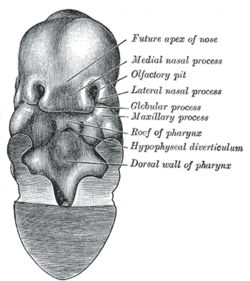Nasal placode
| Nasal placode | |
|---|---|
 Nasal pit shown as olfactory pit | |
| Details | |
| Gives rise to | olfactory epithelium |
| System | Olfactory system |
| Identifiers | |
| Latin | placoda nasalis, placoda olfactoria |
| TE | E5.3.0.0.0.0.8 |
| Anatomical terminology | |
The nasal placode (or olfactory placode[1]) gives rise to the olfactory epithelium of the nose. Two nasal placodes arise as thickened ectoderm from the frontonasal prominence. During the fifth week of development the placodes increase in size. In the sixth week of development the centre of each placode grows inwards to form the two nasal pits. The invaginations will give rise to the olfactory epithelium that lines the nasal cavities.[2]
The nasal pits are oval shaped and they leave a raised margin which is divided into a medial nasal prominence and a lateral nasal prominence.[2]
The medial and lateral nasal prominence of each placode gives rise to the nose, the philtrum of the upper lip and the primary palate.[2]
See also
References
This article incorporates text in the public domain from the 20th edition of Gray's Anatomy (1918)
External links
- http://embryology.med.unsw.edu.au/Notes/week4_3.htm#nose
- http://www.ana.ed.ac.uk/database/humat/notes/embryo/sensory/nose.htm